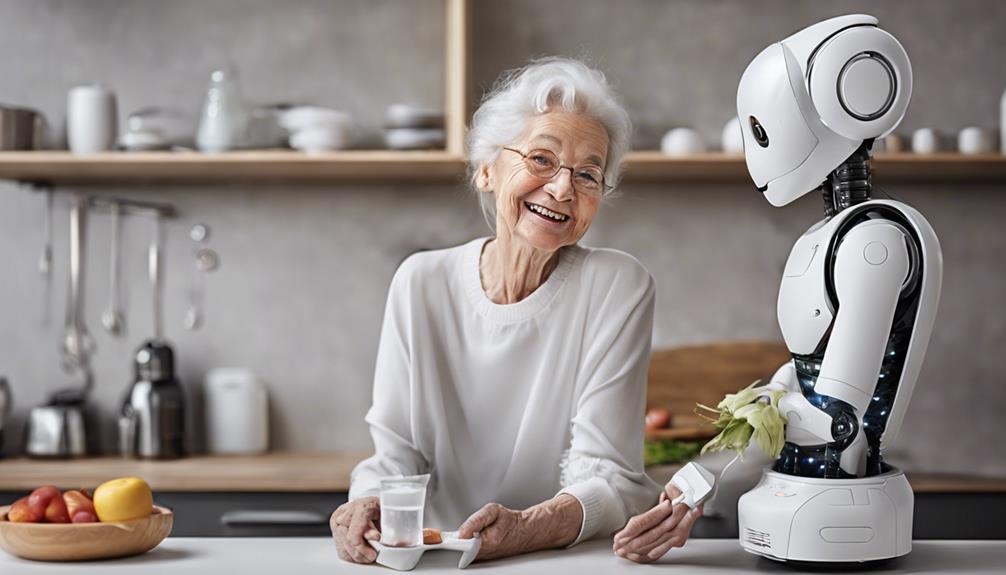Care robots assist elderly individuals in completing everyday tasks, monitoring their health, and promoting independence. They assist with activities like bathing, dressing, and remind individuals to take their medications to ensure their safety and well-being. The robots also monitor vital signs and alert caregivers of any issues promptly. By improving safety and well-being, these robots are able to adjust to the individual’s needs and encourage autonomy. They also play a role in detecting problems early and supporting independent living. Through engaging activities, the robots help stimulate cognitive abilities and aid in physical therapy. These advancements in technology are transforming caregiving and changing how assistance is provided to older populations effectively. Learn more about how care robots are revolutionizing support for aging individuals.
Key Takeaways
- Assist with daily tasks like bathing, dressing, and medication reminders.
- Monitor health indicators for improved safety and well-being.
- Provide companionship and adapt to personal needs.
- Stimulate cognitive abilities through engaging activities.
- Enhance safety monitoring with features like fall detection and real-time alerts.
Benefits of Care Robots for Seniors
Care robots for seniors greatly enhance independence by providing assistance with daily living tasks and monitoring health indicators for improved safety and well-being. These robots play an essential role in promoting autonomy among aging populations. By offering support with tasks like bathing, dressing, and medication reminders, they enable seniors to maintain their independence and quality of life. Additionally, through the monitoring of health indicators such as blood pressure, heart rate, and body temperature, care robots guarantee the safety and well-being of seniors, alerting caregivers in case of any abnormalities.
Moreover, care robots facilitate social interaction and reduce isolation by incorporating features like remote communication and virtual presence in smart homes, allowing seniors to stay connected with their loved ones. The companionship provided by these robots not only enhances emotional well-being but also supports cognitive function by engaging seniors in activities, exercises, and feedback mechanisms that help delay cognitive decline. Overall, the benefits of care robots for seniors extend beyond just physical assistance, encompassing a holistic approach to enhancing the lives of aging individuals. Additionally, care robots can monitor daily cognitive tasks and provide reminders for medication or appointments, promoting independence while offering support when needed. This consistent engagement has the potential to slow down **normal agerelated cognitive decline** by encouraging mental stimulation and routine activities. By integrating these technologies, care robots play a crucial role in maintaining a sense of autonomy and purpose in seniors’ lives.
Daily Living Assistance by Robots
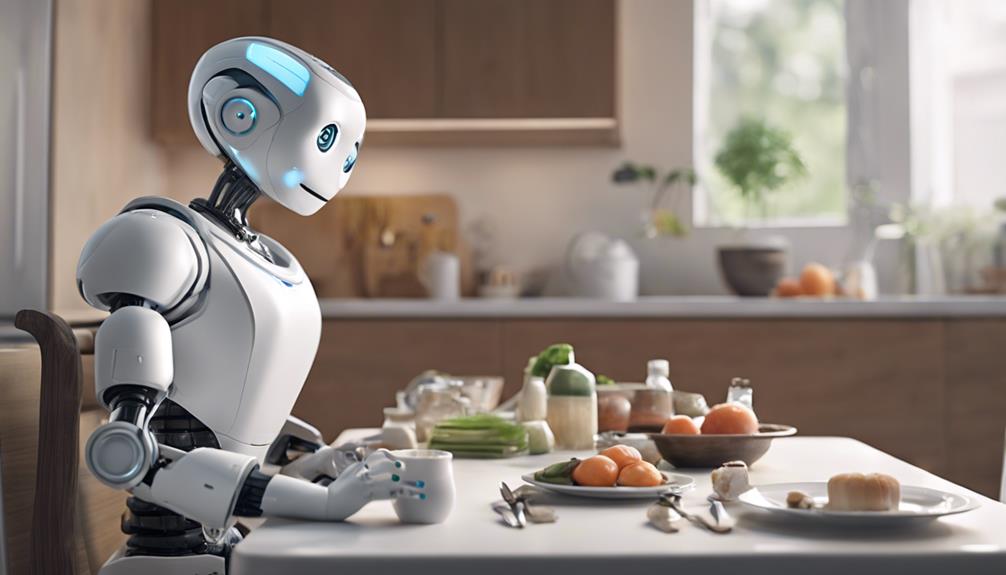
Daily living assistance provided by robots revolutionizes the way seniors maintain their independence and well-being, offering support with essential tasks and health monitoring to enhance their quality of life. These robots assist with daily activities like bathing, dressing, and meal preparation, ensuring elderly individuals can continue living independently. Additionally, they play an important role in reminding seniors of medication schedules, aiding in mobility challenges, and even facilitating physical therapy sessions to promote overall well-being.
In addition to physical support, care robots also provide companionship, which is essential for mental and emotional health. By monitoring health conditions, tracking therapy progress, and stimulating cognitive abilities, these robots help delay cognitive decline and improve cognitive function in aging populations. Ensuring safety is another key aspect of care robots, as they can detect falls in real-time, monitor vital signs such as heart rate and blood pressure, and enable immediate intervention to reduce the risk of injuries among the elderly. Ultimately, these robots contribute significantly to maintaining independence and enhancing the overall quality of life for seniors.
Remote Monitoring and Health Management
Utilizing advanced technology, robots facilitate remote monitoring and health management for aging individuals, promoting proactive healthcare and timely intervention. Care robots equipped with AI algorithms and sensors can remotely track vital signs like body temperature, blood pressure, and heart rate. This continuous monitoring allows for early detection of any abnormalities, guaranteeing prompt medical attention when needed.
Additionally, these robots are designed to detect falls in real-time, greatly reducing the risk of injuries and enhancing safety for aging populations. By providing valuable health insights and enabling proactive healthcare management, care robots empower individuals to take control of their well-being and maintain independence.
The remote monitoring capabilities not only offer quick access to medical assistance but also ensure continuity of care, ultimately supporting aging individuals in leading more autonomous and secure lives. Care robots play a crucial role in promoting independence and proactive health management among aging populations, contributing to improved quality of life.
Enhancing Well-being and Safety
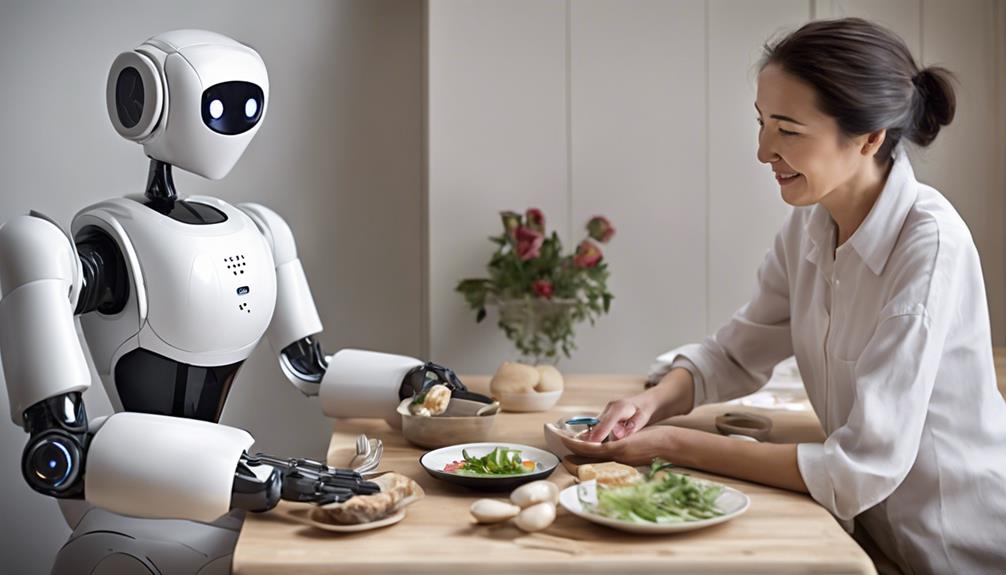
Care robots play a vital role in enhancing well-being and safety for aging individuals. They monitor health conditions, provide companionship, and adapt to personal needs, ensuring a sense of security.
Safety Monitoring Systems
Enhancing well-being and safety through advanced safety monitoring systems in care robots is crucial for ensuring the independence and health of aging populations. These systems utilize AI algorithms and sensors to detect falls in real-time, promptly alerting emergency services to reduce the risk of injuries.
Additionally, health monitoring features track essential signs like body temperature, blood pressure, and heart rate, providing valuable insights into the individual's well-being. By ensuring prompt intervention and early detection of health problems, safety monitoring systems integrated into care robots play a critical role in enhancing the overall safety and promoting independent living for aging populations.
Improved Daily Tasks
How do care robots contribute to the improvement of daily tasks for aging individuals while enhancing their well-being and safety?
Care robots play a crucial role in assisting with daily activities such as meal preparation, bathing, medication reminders, and dressing. By providing companionship, monitoring health, and aiding in mobility impairments, these robots help maintain independence and autonomy.
They guarantee routine activities are carried out efficiently, promoting overall well-being. Care robots also support individuals with health monitoring features like body temperature and heart rate checks, contributing to early problem detection.
Redefining Caregiving With Robots
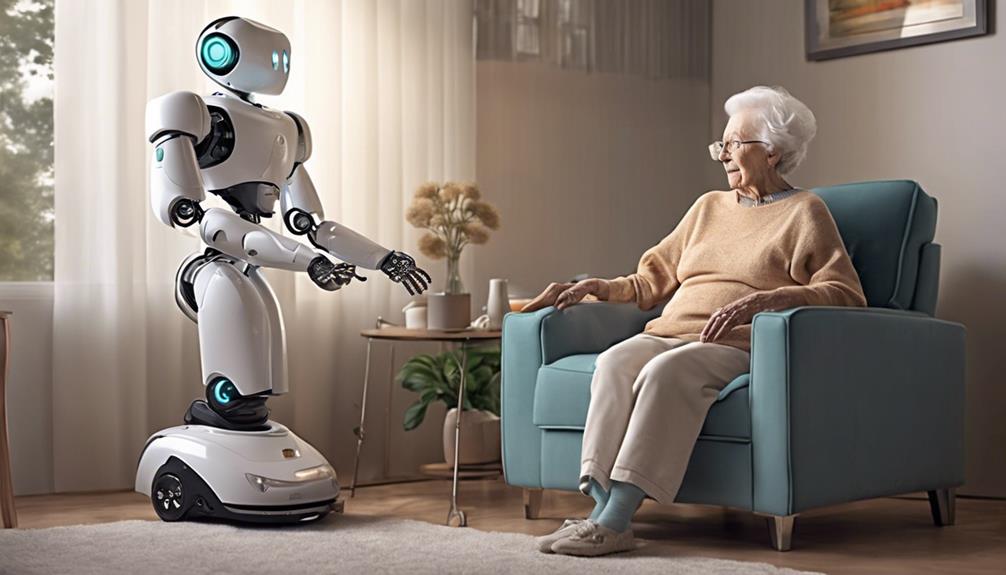
Redefining the traditional role of caregivers, robots are revolutionizing how assistance is provided in daily activities for aging populations. These robots assist older adults in various ways, from healthcare management to promoting independence and well-being. Here are three key ways in which robots are reshaping caregiving:
- Enhancing Safety Monitoring: Care robots play an important role in ensuring the safety of older people by offering features like fall detection, real-time alerts, and tracking essential signs. This constant monitoring helps in early detection of health issues, providing peace of mind to both the seniors and their families.
- Stimulating Cognitive Abilities: Care robots are designed to engage older adults in activities that stimulate their cognitive abilities. By providing mental challenges and interactive tasks, these robots help in maintaining and even improving cognitive functions, contributing to overall mental well-being.
- Facilitating Physical Therapy: Robots are instrumental in facilitating physical therapy for aging populations. Through guided exercises and personalized routines, these robots assist individuals in improving their physical health and mobility, promoting a more active and independent lifestyle.
Meal Preparation and Medication Reminders
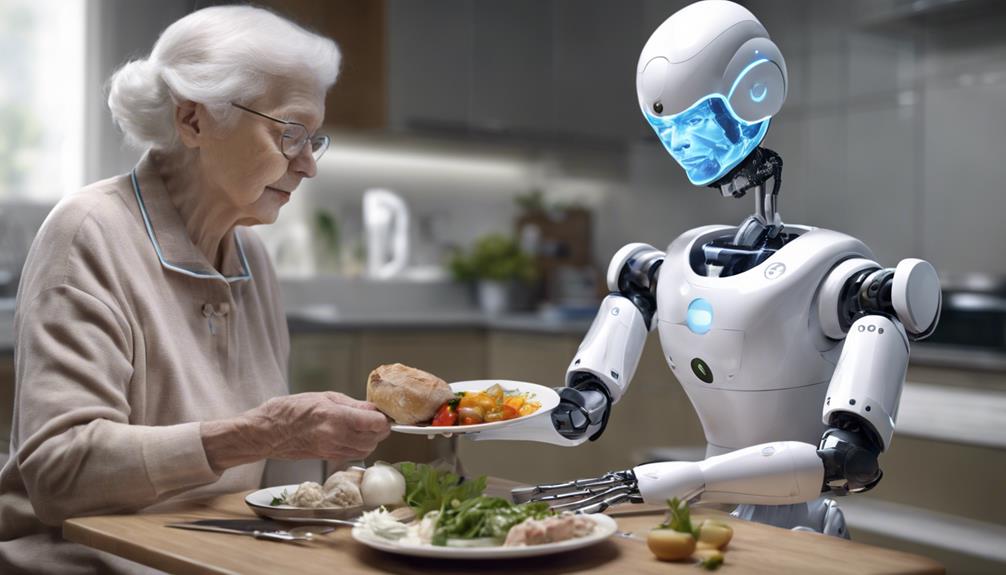
Robots revolutionize caregiving by assisting in meal preparation and providing medication reminders for aging populations, ensuring essential independence and health maintenance. Care robots play a vital role in supporting older adults with meal preparation, helping them maintain proper nutrition management. These robots can bring food from the plate to the mouth, allowing individuals to eat at their own pace and promoting independence during mealtimes. Additionally, they cater to the specific needs of users, offering customized solutions tailored to individual preferences and dietary requirements.
In addition to meal assistance, care robots excel in providing medication reminders to aging populations. By ensuring timely intake and adherence to prescribed schedules, these robots help prevent missed doses and enhance safety for older adults. This support not only promotes better health outcomes but also reduces the risk of potential complications due to medication non-adherence. With care robots handling meal preparation and medication reminders, older adults can enjoy greater independence and well-being in their daily lives.
Bathing, Dressing, and Personal Care Support

In assisting aging populations, care robots play a pivotal role in providing support for bathing, dressing, and personal care needs, enhancing independence and well-being. When it comes to maintaining autonomy and dignity in everyday tasks, care robots offer invaluable assistance to the elderly.
Here are three ways in which these robots support bathing, dressing, and personal care:
- Bathing Support: Bathing robots such as ultrasonic bath systems and robotic assistants guarantee safe and soothing bathing experiences for the elderly, reducing the risk of falls and promoting relaxation during this essential daily routine.
- Dressing Assistance: Dressing support robots help individuals maintain independence by providing aid with clothing selection, fastening buttons, and other personal grooming tasks, allowing older adults to dress themselves confidently and with ease.
- Personal Care Aid: Personal care robots assist with tasks like hair brushing, tooth brushing, and nail care, ensuring proper hygiene and overall well-being for aging populations, thereby supporting their independence and dignity in daily self-care routines.
Frequently Asked Questions
How Can Robots Support Care for Elderly People?
Robots support care for elderly people by assisting with daily activities, monitoring health, and promoting independence. They enhance safety, provide companionship, and encourage cognitive abilities. We believe in using technology to empower and improve lives.
What Are Three Ways Robots Could Help Elderly?
We believe care robots can assist the elderly by offering support in daily tasks, monitoring health conditions, and providing companionship. These services greatly enhance independence, well-being, and quality of life for aging populations.
How Are Robots Used in Aged Care?
Robots in aged care assist with daily tasks, provide companionship, and monitor health. They promote independence, enabling older adults to stay active and connected. By automating activities and offering support, robots help maintain autonomy and well-being.
How Robots Can Make Aging in Place More Enjoyable?
We can't imagine life without care robots! They transform aging in place into a joyous journey, improving daily tasks, boosting well-being, and fostering independence. With their support, every moment becomes more delightful and fulfilling.
Conclusion
To sum up, care robots play a vital role in supporting independence for aging populations. One interesting statistic to note is that by 2050, it's estimated that there will be over 2 billion people aged 60 and older worldwide.
With the help of care robots, seniors can receive assistance with daily tasks, health monitoring, and personal care, allowing them to maintain their independence and live comfortably in their own homes.
